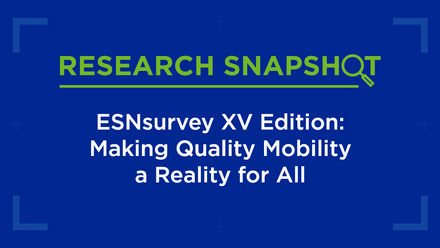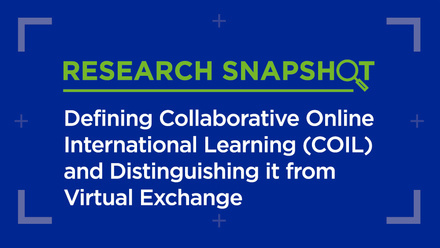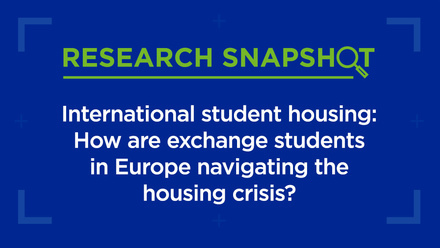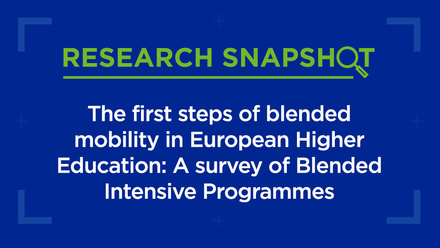5 tips for running Erasmus+ Blended Intensive Programmes

Students and academics in higher education institutions (HEIs) across Europe have returned to the classroom and with them, it seems, a new attention towards new formats of learning and teaching. Having lived through the unexpected disruption of on-site teaching, all players of the university learning communities appear more conscious about the pros and cons of on-site and online learning. For HEIs in the European Higher Education Area, the new Erasmus+ Blended Intensive Programmes (BIPs) hold unique opportunities for bringing the best of both worlds together: virtual teaching is preceded and/or followed by a short period of physical mobility and thus allows for meaningful encounters between participants from at least three European HEIs. High time to take a closer look at how both modalities can enrich each other!
At the moment, many HEIs face a particular challenge with regard to the implementation of their BIPs, ie the fact that the funding of these programmes is contingent on at least 15 mobile learners in the programme. In turn, student drop-outs endanger the realisation of the entire programme. This is an issue that HEIs can begin to tackle at a formal level, eg by opting for a consortium of four (instead of three) partners, and by planning well ahead to allow students sufficient time to organise their participation and the recognition of credits, to make travel arrangements and thereby commit to the programme.
Lessons from virtual exchange
Beyond this, however, we can learn much from previous research into distance education and virtual exchange (VE). In her research into community-building in online distance classes, Dr. Ruth Brown of the University of Nebraska at Kearney found that students will ideally progress through three different levels: from making acquaintances online, to detecting similarities with other students and engaging with each other academically in order to meet the course requirements, to gradually engaging in more in-depth discussions. A feeling of community, she argues, emerges when students engage in a “long, thoughtful, threaded discussion on a subject of importance to all,” in which they feel comfortable sharing their opinion, feel that their voice is heard and leave the discussion confident of their ability to communicate. It is not surprising that the more deeply students engage, the more they will feel committed to the programme – and the less likely they will lose touch with the class community and drop out.
Within the typically short time span of the BIP, students’ learning unfolds along complex axes: they encounter new content and forge interdisciplinary connections; they encounter others, whose views will be different from their own; they encounter a new place (or in the case of the local learners, encounter their city or region anew), and, in all of this, they are challenged to encounter themselves and their previous knowledge, views and opinions. These encounters take time to digest.
It is not surprising that the more deeply students engage, the more they will feel committed to the programme
One of the standard practices of VE – reflection – could be useful in this context. We know that students do not learn from the experience itself, but rather from reflecting upon the experience and making the connection between the newly acquired knowledge, skills or attitude and their graduate profile. Reflection is not limited to the last phase of learning, but can be practised throughout the project: before, during and after the BIP. In addition, there are many ways to reflect: as a group or individually, in writing or using other means of communication – such as a dialogue, a visualisation etc – and the field of VE has many best practices to share.
Designing Blended Intensive Programmes
Co-designing a BIP for the first time will certainly require more time than organising the module at home with local students only. Here are some thoughts that BIP facilitators may keep in mind:
1.Making the organisation effective and enjoyable: Much like their students, the BIP facilitators in the consortium will engage in an intercultural encounter with joys, jokes and likely some friction. Take time to get to know your co-facilitators! If possible, a physical meeting during the early planning stages will help build trust. Be clear about expectations, negotiable and non-negotiable standards, previous knowledge you want to build this course on, and the support structures you may want to offer jointly and/or locally to guide students through the programme.
2. Synchronous BIP learning: Considering what content students will engage with online is critical: not all student interaction is suitable for an online setting, but if we make intentional choices in what we teach and how it is taught, BIP learning can be the best of both worlds. Suitable synchronous learning can include – but is not limited to – icebreakers, presentation of new information or knowledge, (guest) lecturing or collaborative tasks designed for online engagement.
3. Asynchronous BIP learning: Much like the traditional in-person classroom, not all learning occurs while students are in the presence of their teacher. The advantage of asynchronous learning is that this process can still be collaborative, by making use of educational technology. Students work together on knowledge acquisition by collating information in a Google document, a Padlet wall or an online mind map. Asynchronous does not equal individual, and, if developed intentionally, can help students prepare for the synchronous and in-person engagements.
Asynchronous does not equal individual – it can help students prepare for synchronous and in-person engagements
4. Getting the on-site experience right: The on-site week will work best if the most is made of the physical experience of space – through teaching approaches, experiential learning and networking opportunities that fill virtually-formed relationships with additional meaning or form new ones. The virtual and on-campus content should be as seamless and closely interwoven as possible. Challenge-based, community-building elements can add to this. Human perception will still mean that the on-site part of the programme will be seen as a – if not the – highlight of the entire experience, thus it is important to get it right. This is where it can be beneficial to work with other teams at university that are focusing on summer or short-term programming. In the EAIE context we are recognising this through increasing collaboration between the Summer Schools and Internationalisation at Home Expert Communities. In practice, BIPs and similar schemes may shape how experts at universities perceive, redefine and widen their work.
The on-site part of the programme will be seen as a – if not the – highlight of the entire experience, thus it is important to get it right
5.Give yourselves a break (or two): Plan for breaks and reflective phases and leave some room for the course dynamics to unfold, without pre-planning every minute of the sessions. Like any virtual (exchange) course, the virtual BIP sessions will require some flexibility and the ability to respond to unforeseen issues.
BIPs are opening up new opportunities for students and are making our campuses more representative of the international workplace. For HEIs, they may evolve into a significant tool for collaboration and this invigorate partnerships. They mix up our palette of learning possibilities and at the same time stretch our understanding of what boundaries within our institutions are, as the skill sets required to make them successful are many. Erasmus+ is to be credited for being a catalyst of that change.






